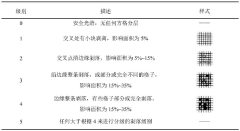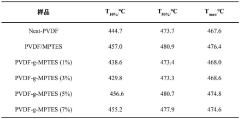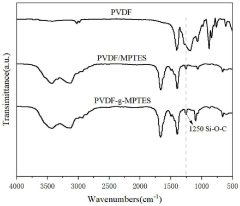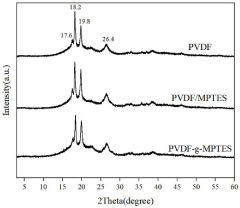How to Enhance PVDF Function in Electroresponsive Coatings?
PVDF in Electrocoatings: Background and Objectives
Polyvinylidene fluoride (PVDF) has emerged as a crucial material in the development of electroresponsive coatings, marking a significant advancement in smart material technology. The journey of PVDF in this field began with the discovery of its unique piezoelectric and ferroelectric properties in the 1960s. Since then, researchers and engineers have been exploring ways to harness these characteristics for various applications, with electroresponsive coatings being one of the most promising areas.
The primary objective in enhancing PVDF function in electroresponsive coatings is to improve its responsiveness to electrical stimuli while maintaining or enhancing its other desirable properties such as chemical resistance, thermal stability, and mechanical strength. This goal aligns with the broader trend in materials science towards creating more adaptive and intelligent surfaces that can change their properties on demand.
PVDF's potential in electroresponsive coatings stems from its ability to undergo conformational changes when subjected to an electric field. This property allows for the creation of coatings that can alter their surface characteristics, such as wettability, adhesion, or even color, in response to electrical inputs. The versatility of PVDF makes it an ideal candidate for applications ranging from self-cleaning surfaces to dynamic camouflage systems.
The evolution of PVDF in electroresponsive coatings has been driven by advancements in polymer science, nanotechnology, and surface engineering. Researchers have been focusing on optimizing the crystalline structure of PVDF, particularly the β-phase, which is responsible for its electroactive properties. Efforts have also been directed towards developing PVDF-based composites and copolymers to enhance its electroresponsive behavior.
One of the key challenges in this field has been to achieve a balance between the electroresponsive function and other practical requirements such as durability, ease of application, and cost-effectiveness. As such, the research objectives have expanded to include not only the enhancement of PVDF's electroactive properties but also the improvement of its overall performance as a coating material.
The current state of PVDF in electroresponsive coatings represents a convergence of multiple scientific disciplines. Materials scientists are working alongside electrical engineers and chemists to develop novel formulations and processing techniques. The goal is to create PVDF-based coatings that can respond rapidly and reversibly to electrical stimuli, while also being robust enough for real-world applications.
Looking forward, the enhancement of PVDF function in electroresponsive coatings is expected to open up new possibilities in smart surfaces and adaptive materials. The potential applications span across industries, from aerospace and automotive to biomedical and consumer electronics. As research progresses, the focus will likely shift towards fine-tuning the response characteristics, improving long-term stability, and developing more sophisticated control mechanisms for these electroactive coatings.
Market Analysis for Enhanced Electroresponsive Coatings
The market for enhanced electroresponsive coatings, particularly those utilizing PVDF (Polyvinylidene Fluoride), is experiencing significant growth driven by increasing demand across various industries. These coatings offer unique properties such as piezoelectricity, pyroelectricity, and ferroelectricity, making them valuable in applications ranging from aerospace to consumer electronics.
In the aerospace sector, electroresponsive coatings are gaining traction for their ability to provide real-time structural health monitoring and de-icing capabilities. The automotive industry is exploring these coatings for smart paint applications that can change color or provide visual feedback based on external stimuli. The consumer electronics market is leveraging PVDF-based coatings for haptic feedback systems and energy harvesting in wearable devices.
The global smart coatings market, which includes electroresponsive coatings, is projected to grow substantially in the coming years. This growth is fueled by advancements in nanotechnology and increasing investments in research and development. The Asia-Pacific region is expected to witness the highest growth rate, driven by rapid industrialization and increasing adoption of smart technologies in countries like China and Japan.
Key market drivers include the growing demand for multifunctional coatings that can adapt to environmental changes, the need for energy-efficient solutions, and the push for lightweight materials in transportation industries. The automotive sector, in particular, is showing strong interest in electroresponsive coatings for their potential in developing self-healing paint systems and energy-harvesting body panels.
However, the market faces challenges such as high initial costs associated with research and development, limited awareness among end-users about the benefits of electroresponsive coatings, and the need for standardization in testing and performance evaluation. Overcoming these hurdles will be crucial for widespread market adoption.
Opportunities for market expansion lie in developing cost-effective production methods, improving the durability and longevity of electroresponsive coatings, and exploring new application areas such as smart textiles and biomedical devices. Collaborations between material scientists, coating manufacturers, and end-user industries are expected to drive innovation and create new market segments.
The competitive landscape is characterized by a mix of established chemical companies and innovative startups. Major players are investing in enhancing the functionality of PVDF in electroresponsive coatings through techniques such as nanocomposite formulations and surface modification. This focus on R&D is expected to lead to breakthroughs in coating performance and expand the potential applications, further driving market growth.
Current PVDF Limitations in Electroresponsive Applications
Polyvinylidene fluoride (PVDF) has gained significant attention in electroresponsive coating applications due to its unique piezoelectric and ferroelectric properties. However, several limitations hinder its widespread adoption and optimal performance in this field.
One of the primary challenges is PVDF's relatively low piezoelectric response compared to ceramic materials. While PVDF offers flexibility and processability advantages, its piezoelectric coefficients are typically an order of magnitude lower than those of common piezoelectric ceramics. This limitation restricts the sensitivity and actuation capabilities of PVDF-based electroresponsive coatings, particularly in applications requiring high precision or large displacements.
Another significant drawback is PVDF's temperature sensitivity. The polymer's piezoelectric properties degrade rapidly at elevated temperatures, with a Curie temperature around 80°C. This thermal instability limits the use of PVDF in high-temperature environments or applications involving significant heat generation, narrowing its potential application range in electroresponsive coatings.
PVDF's polymorphism presents both opportunities and challenges. The β-phase, which exhibits the strongest piezoelectric response, is not the thermodynamically stable form at room temperature. Achieving a high β-phase content often requires additional processing steps, such as mechanical stretching or electrical poling, which can complicate manufacturing processes and increase production costs for electroresponsive coatings.
The inherent softness of PVDF can also be problematic in certain applications. While its flexibility is advantageous in some scenarios, it can lead to reduced durability and wear resistance in coatings subjected to mechanical stress or abrasion. This limitation may necessitate additional protective layers or composite formulations, potentially compromising the overall electroresponsive performance.
PVDF's chemical resistance, while generally good, can be a double-edged sword in electroresponsive coating applications. Its inertness can make it challenging to achieve strong adhesion to certain substrates or to incorporate functional additives that might enhance its electroresponsive properties. This limitation can restrict the design flexibility and performance optimization of PVDF-based coatings.
Lastly, the electrical properties of PVDF, particularly its relatively high dielectric constant compared to other polymers, can lead to increased capacitive effects in electroresponsive applications. This characteristic may result in unwanted electrical noise or reduced sensitivity in sensing applications, requiring careful circuit design and signal processing to mitigate these effects.
Addressing these limitations is crucial for enhancing PVDF's functionality in electroresponsive coatings. Future research and development efforts should focus on overcoming these challenges through innovative material modifications, processing techniques, and composite formulations to fully harness PVDF's potential in this rapidly evolving field.
Existing PVDF Enhancement Techniques for Electrocoatings
01 Piezoelectric properties and applications
PVDF exhibits strong piezoelectric properties, making it suitable for various applications in sensors, actuators, and energy harvesting devices. Its ability to convert mechanical stress into electrical signals and vice versa allows for the development of pressure sensors, vibration detectors, and ultrasonic transducers.- Electrical and electronic applications: PVDF is widely used in electrical and electronic applications due to its excellent dielectric properties and piezoelectric characteristics. It can be used in sensors, actuators, and transducers, as well as in energy harvesting devices. PVDF's ability to convert mechanical stress into electrical signals makes it valuable for various sensing and energy conversion applications.
- Membrane and filtration technology: PVDF is extensively used in membrane and filtration applications due to its chemical resistance, thermal stability, and mechanical strength. It is employed in water treatment systems, industrial separations, and biomedical applications. PVDF membranes offer high flux rates and excellent fouling resistance, making them suitable for various separation processes.
- Coating and protective applications: PVDF is utilized in coating and protective applications due to its excellent weatherability, UV resistance, and chemical inertness. It is commonly used in architectural coatings, protective films, and corrosion-resistant linings. PVDF coatings provide long-lasting protection against environmental factors and maintain their appearance over time.
- Battery and energy storage applications: PVDF plays a crucial role in battery and energy storage applications, particularly in lithium-ion batteries. It is used as a binder material for electrode components, enhancing the stability and performance of batteries. PVDF's chemical stability and adhesive properties contribute to improved battery life and efficiency.
- Automotive and aerospace applications: PVDF finds applications in the automotive and aerospace industries due to its lightweight nature, chemical resistance, and thermal stability. It is used in fuel systems, hydraulic lines, and interior components. PVDF's ability to withstand harsh environments and its low friction properties make it suitable for various automotive and aerospace applications.
02 Membrane and filtration applications
PVDF is widely used in membrane technology for water treatment, gas separation, and other filtration processes. Its chemical resistance, thermal stability, and porous structure make it an excellent material for microfiltration and ultrafiltration membranes, contributing to improved water purification and industrial separation processes.Expand Specific Solutions03 Electrical insulation and wire coating
PVDF's excellent dielectric properties and resistance to high temperatures make it suitable for electrical insulation applications. It is used as a coating material for wires and cables in various industries, including automotive, aerospace, and electronics, providing protection against electrical breakdown and environmental factors.Expand Specific Solutions04 Chemical resistance and protective coatings
PVDF's outstanding chemical resistance to acids, bases, and organic solvents makes it an ideal material for protective coatings in harsh environments. It is used in chemical processing equipment, storage tanks, and pipelines to prevent corrosion and extend the lifespan of industrial infrastructure.Expand Specific Solutions05 Photovoltaic and energy storage applications
PVDF is utilized in the production of solar cells and energy storage devices due to its excellent weatherability and stability. It serves as a binder material in lithium-ion battery electrodes and as a backsheet material in photovoltaic modules, contributing to improved performance and durability of renewable energy technologies.Expand Specific Solutions
Key Industry Players in PVDF and Electrocoating Sectors
The market for enhancing PVDF function in electroresponsive coatings is in a growth phase, driven by increasing demand for smart materials in various industries. The global market size is expanding, with significant potential in automotive, electronics, and construction sectors. Technologically, the field is advancing rapidly, with companies like Arkema France SA, DuPont Electronics, Inc., and Kureha Corp. leading in PVDF innovations. Academic institutions such as Tsinghua University and Zhejiang University are contributing to research advancements. The technology maturity varies, with established players offering commercial solutions while newer entrants like Ningde Zhuo High-tech Materials Technology Co., Ltd. and Shenzhen Jiana Energy Technology Co., Ltd. are developing novel applications, indicating a dynamic and competitive landscape.
Arkema France SA
DuPont Electronics, Inc.
Innovative PVDF Modification Approaches
- By introducing MPTES as a grafting monomer, polar functional groups such as double bonds and ester groups are used to perform melt grafting with PVDF to enhance the adhesion and compatibility of PVDF. The specific method includes drying MPTES and PVDF in an oven, using a torque rheometer for reaction, and obtaining PVDF materials with high compatibility and adhesion through cryogenic crushing and purification.
- A coating liquid containing a polar solvent, hydrophilic polymer, and PVDF, with specific components like chitosan derivatives and conductive materials, forming a coating film with a concentration gradient that ensures adhesion and non-adhesiveness, chemical resistance, and conductivity.
Environmental Impact of Enhanced PVDF Coatings
The enhancement of PVDF function in electroresponsive coatings brings both benefits and potential environmental concerns. As these advanced coatings gain wider application, it is crucial to assess their environmental impact throughout their lifecycle.
During the production phase, the synthesis of enhanced PVDF coatings may involve the use of solvents and additives. While PVDF itself is generally considered environmentally friendly, the manufacturing process could potentially release volatile organic compounds (VOCs) or other pollutants. However, advancements in green chemistry and sustainable manufacturing practices are continuously improving the environmental footprint of production processes.
The application of enhanced PVDF coatings can contribute to energy efficiency in various sectors. For instance, in building applications, these coatings can improve thermal management, potentially reducing energy consumption for heating and cooling. In the automotive industry, electroresponsive PVDF coatings may lead to lighter vehicles, thereby improving fuel efficiency and reducing emissions.
The durability and longevity of enhanced PVDF coatings also play a significant role in their environmental impact. These coatings typically have extended lifespans compared to traditional alternatives, which can reduce the frequency of reapplication and associated waste generation. Additionally, their resistance to weathering and chemical degradation may decrease the leaching of potentially harmful substances into the environment over time.
However, the end-of-life disposal of products containing enhanced PVDF coatings presents challenges. While PVDF is recyclable, the presence of additives and other materials in the coating system may complicate the recycling process. Proper disposal and recycling protocols need to be developed to ensure that these materials do not contribute to environmental pollution or accumulate in landfills.
The potential for nanomaterials in some enhanced PVDF coatings raises questions about their long-term environmental effects. While these materials can significantly improve coating performance, their impact on ecosystems and human health is still being studied. Ongoing research is essential to understand and mitigate any potential risks associated with nanoparticle release into the environment.
Overall, the environmental impact of enhanced PVDF coatings is a complex issue that requires a holistic approach. While these coatings offer potential benefits in terms of energy efficiency and durability, careful consideration must be given to their entire lifecycle. Continued research and development efforts should focus on minimizing environmental impacts during production, optimizing performance for sustainability, and improving end-of-life management strategies.
Scalability and Cost-Effectiveness Analysis
The scalability and cost-effectiveness of enhancing PVDF function in electroresponsive coatings are critical factors for industrial adoption and commercial viability. The production of PVDF-based electroresponsive coatings can be scaled up through various methods, including solution casting, melt extrusion, and electrospinning. Each method presents unique advantages and challenges in terms of scalability and cost.
Solution casting offers a relatively simple and cost-effective approach for large-scale production. This method allows for precise control over film thickness and uniformity, which is essential for consistent electroresponsive performance. However, it may require significant energy input for solvent evaporation, potentially increasing production costs.
Melt extrusion, on the other hand, is highly scalable and eliminates the need for solvents, reducing environmental impact and associated costs. This method is particularly suitable for continuous production of PVDF films or fibers. However, the high processing temperatures required may lead to thermal degradation of certain functional additives, potentially limiting the enhancement of PVDF's electroresponsive properties.
Electrospinning offers the advantage of producing high-surface-area PVDF nanofibers, which can significantly enhance the electroresponsive properties. While this method has traditionally been limited in scalability, recent advancements in multi-nozzle and needleless electrospinning technologies have improved its potential for large-scale production.
Cost-effectiveness analysis reveals that raw material costs, particularly for high-purity PVDF and functional additives, constitute a significant portion of the overall production expenses. Strategies to reduce costs include optimizing material formulations, exploring alternative sourcing options, and developing recycling processes for production waste.
Energy consumption during production is another major cost factor. Implementing energy-efficient processing techniques and utilizing renewable energy sources can help mitigate these costs. Additionally, investing in automation and process control systems can improve production efficiency and reduce labor costs in the long term.
The scalability of enhancing PVDF function also depends on the specific enhancement method employed. Surface modification techniques, such as plasma treatment or chemical grafting, may face challenges in maintaining uniformity across large surface areas. In contrast, bulk modification methods, like blending with functional additives or copolymerization, may offer better scalability but could impact the overall cost and material properties.
Considering the growing demand for smart and responsive materials, the potential market for enhanced PVDF electroresponsive coatings is substantial. This market potential can justify initial investments in scaling up production and optimizing processes for cost-effectiveness. As production scales increase, economies of scale are likely to drive down per-unit costs, further improving the economic viability of these advanced materials.



